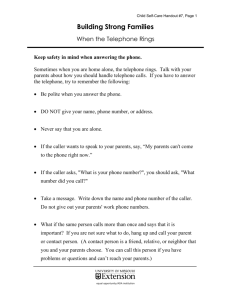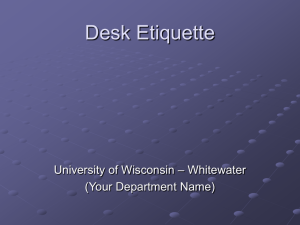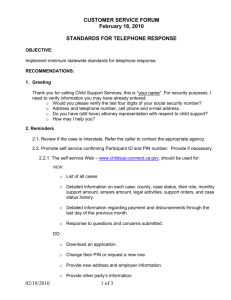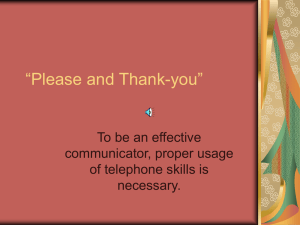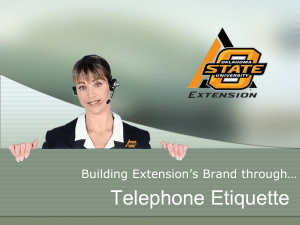PPT Communicate on the telephone 290812
advertisement
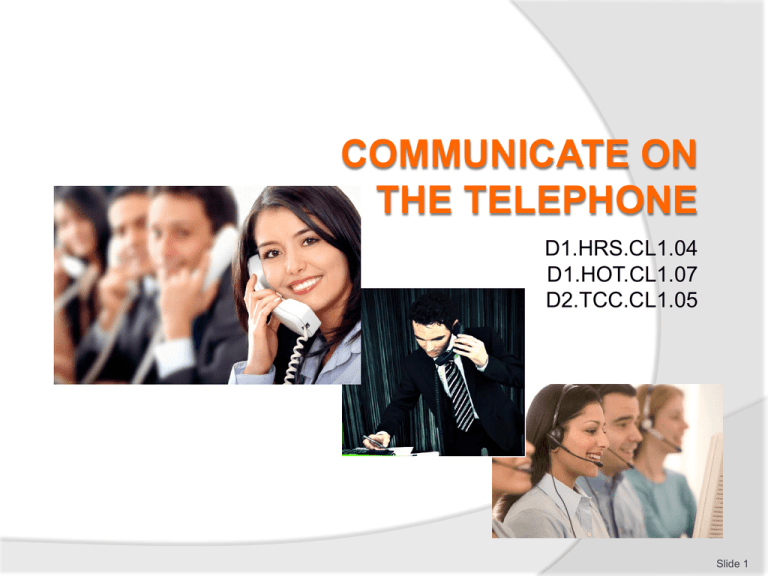
COMMUNICATE ON THE TELEPHONE D1.HRS.CL1.04 D1.HOT.CL1.07 D2.TCC.CL1.05 Slide 1 Communicate on the telephone This Unit comprises two Elements: 1. Respond to incoming telephone calls 2. Make telephone calls. Slide 2 Assessment Assessment for this Unit may include: Oral questions Written questions Work projects Workplace observation of practical skills Practical exercises Formal report from employer/supervisor. Slide 3 Respond to incoming telephone calls Performance Criteria for this Element are: 1.1 Answer calls promptly in an appropriate manner in accordance with enterprise standards 1.2 Offer friendly assistance to the caller and accurately establish the purpose of the call 1.3 Repeat call details to the caller to confirm understanding 1.4 Answer caller enquiries promptly or transfer caller to the appropriate location or person (Continued) Slide 4 Respond to incoming telephone calls 1.5 Record caller requests accurately and pass on to the appropriate department or person for follow-up 1.6 Relay messages accurately to the nominated person within designated timelines 1.7 Report threatening or suspicious phone calls promptly to the appropriate person in accordance with enterprise procedures 1.8 Use language, tone and volume appropriate to phone calls. Slide 5 Answering calls promptly Customers can use the phone to: Make reservations for rooms, tours and travel Check, query, modify or cancel arrangements already made Make enquiries about functions Seek information about prices and products Lodge compliments and complaints. Slide 6 Answering calls promptly Failure to answer the telephone promptly and correctly can result in: Loss of business or revenue Loss of jobs Poor or negative customer relations Customers who are more difficult to deal with Reduced business image in the eyes of customers. Slide 7 Answering calls promptly Staff also use the phone on behalf of customers and for business reasons to: Communicate with other staff or departments Seek clarification about work directions Contact nominated people in the event of an emergency situation Provide feedback to management and co-workers Obtain help or stock (Continued) Slide 8 Answering calls promptly Order stock from suppliers Make bookings with providers Cold call prospects Place service or maintenance calls with support organisations Seek advice from government authorities, industry bodies, and a range of business advisors. Slide 9 Answering calls promptly Every time you use the phone at work you are the business Callers – and people you call – judge the business by the way you handle the call Common, big mistakes telephone users make is to: Not answer calls promptly Take the telephone for granted Believe use of the telephone comes ‘naturally’. Slide 10 Answering calls promptly An appropriate telephone manner must be applied when using the telephone: Using polite language at all times Using appropriate welcoming or greeting phrases Showing enthusiasm when taking a call Being friendly Making an offer of help to the caller. Slide 11 Answering calls promptly You will become aware of your workplace ‘enterprise standards’ for answering or using the telephone in the following ways: On-the-job training Personal observation Reading company policy on Telephone Use or Operation Reading relevant section of Employee’s Handbook. Slide 12 Answering calls promptly Enterprise standards may relate to: The use of appropriate greetings or welcoming phrases when answering the telephone. These may require you to: Greet the caller Identify the business Identify yourself Make an offer of assistance It is never acceptable to simply pick up the phone and say: “What?”, “Yes” or “Hello”. (Continued) Slide 13 Answering calls promptly Use of the caller’s name Making an offer of assistance : Make an initial offer of help to the caller Be responsive to directing the call : ○ “It sounds as if you need to talk to our Function department Manager, Mr Maguire. I’ll connect you to Mr Thomas, our Banquet Manager” ○ “I think you need to talk to Peter, he’s in charge of reservations” Take a message : ○ “I’m sorry Mr Smith, Mr Grey is unavailable at the moment. Can I take a message and get him to ring you back?” Do not answer someone else’s extension or phone. Slide 14 Answering calls promptly When placing a call ‘on hold’: Do it courteously Ask the caller if they want to be placed ‘on hold’ Listen to their answer and act accordingly Get back to all calls ‘on hold’ every 30 seconds. Slide 15 Offering assistance and establishing the purpose of the call Always use a friendly tone when answering the phone The key to answering caller enquiries is to be genuinely helpful: Focus just on the call Try to understand the caller’s problem or situation Ask questions Put yourself in the caller’s shoes Take time with the call Check the caller’s level of satisfaction with what is being provided and what is happening with their call. Slide 16 Offering assistance and establishing the purpose of the call When you have provided an appropriate greeting and welcome you need to: Quickly identify why the caller has phoned: Ask questions Never assume anything from one or two words spoken by the caller Use active listening Take brief notes. Slide 17 Repeating call details It may be necessary to repeat call details to the caller to confirm or clarify the purpose of the call from the caller’s perspective. Repeating call detail requires: Awareness this may need to be done Awareness the caller never knows the business the way you do Stating back to the caller what you believe they have said, what they want or what they have asked for Asking questions. Always keep the caller advised of what you are going to do. Slide 18 Repeating call details When taking a telephone reservation (for travel, tours, rooms, dining), make sure you: Capture the basic information about the booking Record information into appropriate register or on to appropriate system Apply standard customer service techniques Apply standard sales techniques. Slide 19 Repeating call details The call you are answering must be your primary focus: Never interrupt answering this call to answer another call unless this is a specific organisation requirement Never be distracted by another call when answering this call Never be distracted by in-person customers when answering a call. The Golden Rule when dealing with a phone call is to focus completely on the caller you are dealing with. Slide 20 Repeating call details Where you need to interrupt one call to answer another call, the following is a useful guide on how handle this situation: Excuse yourself from the caller you are talking to Answer the other incoming call and process it in some way, quickly Go back to the original caller, apologise for the interruption and continue to focus on that call. Slide 21 Answering caller enquiries or transferring calls To respond effectively yourself to caller enquiries: Identify exact nature of enquiries as soon as possible Have resources handy you can refer to help deal with calls Develop a detailed internal telephone list. Slide 22 Answering caller enquiries or transferring calls To optimise customer service when answering caller enquiries: Put a smile in your voice Ensure the caller can see you are trying to help them Keep them informed Always be honest Refer to documents or other staff where you are unsure Realise as quickly as you can when you cannot help the caller any more Try harder when you are on the telephone. Slide 23 Answering caller enquiries or transferring calls To respond effectively yourself to caller enquiries: Apologise – if appropriate – for the need to transfer the call Explain why you need to transfer the call Tell them who you want to transfer them to Ask permission to transfer their call Transfer the call and monitor it. Slide 24 Answering caller enquiries or transferring calls To respond effectively yourself to caller enquiries: Apologise Ask if they know who might be able to help them – or suggest someone Ask if you can take a message and have the person ring them back Pass the message on to the appropriate person Monitor the action taken in response to the call. Slide 25 Answering caller enquiries or transferring calls If you cannot answer questions asked, an appropriate response is: Apologise Ask caller if you can make some enquiries yourself and get back to them Take their details and details of the query Thank them for their call Find out the required answers Phone them back – as and when arranged or promised. Slide 26 Answering caller enquiries or transferring calls If you are having difficulty obtaining answers to their questions: Ring them Apologise Explain the situation Let them know you are still following up Make a time to phone them back with the required answers. Slide 27 Answering caller enquiries or transferring calls Tips to follow when transferring a telephone call include: Transfer calls promptly Locate the required person for the caller Not transferring calls to people you know are not there Only try to transfer a call once to an extension Give caller choices if the required person is unavailable. Slide 28 Answering caller enquiries or transferring calls All promises made on the telephone must be kept, when promised, as promised. Keeping promises made on the telephone: Builds confidence Values and respects the caller Differentiates the business from others. Slide 29 Recording and passing on messages Where a telephone message has to be taken, do so: Cheerfully Using the designated telephone message form Making sure you capture all the information the caller gives you Ensuring you get the details correct Repeating the message back to the caller to confirm it Thanking the caller. Slide 30 Recording and passing on messages When a telephone message has been taken it must be passed on: To the appropriate person Promptly In hard copy form. It is never sufficient just to take a telephone message: Check the person has picked up their message Check they have acknowledged your email Speak to the person to ask if they have received the message. Slide 31 Recording and passing on messages Most businesses use a standard form telephone message pad/form to record telephone messages: They are ‘duplicate’ – top copy goes to receiver of message; bottom copy stays in book/pad When recording a phone message: Write legibly Put your name or initials on the message Include caller details Include ‘action required or promised’. Slide 32 Recording and passing on messages Further points to observe when taking telephone messages: Use any internal electronic system in place at the business: Facilitates recording of message Saves time Makes distribution of messages easier Never take messages on scraps of paper: It is unprofessional They are easy to lose They do not prompt you to capture all message details. Slide 33 Relaying telephone messages Check with Supervisor for company procedures for relaying telephone messages. Options include: Placing in person’s pigeon hole Pinning it on the staff notice board Sending the person an email Physically taking the message and handing it to them Leaving the person a voice message to let them know they have a message. Slide 34 Relaying telephone messages Additional points to note regarding relaying telephone message include: Never leave telephone messages in the telephone message book Always follow up on messages Relay all telephone messages promptly Notify Supervisor where messages have not or cannot be delivered. Slide 35 Reporting threatening or suspicious phone calls Where you receive a threatening or suspicious phone call: Adhere to workplace requirements as set out in policies and procedures, on-the-job training Ask questions Use specific form to record call and caller details Alert management as soon as possible NEVER treat call as a hoax. Slide 36 Reporting threatening or suspicious phone calls If you receive a bomb threat phone call: Record the call on a Bomb Threat form Ask lots of questions such as [see Bomb Threat Form/Checklist]: What kind of bomb is it? What will cause it to explode? Why did you plant it? Alert nearby staff you are taking a bomb threat Treat every call as genuine. Slide 37 Using appropriate language, tone and volume Standard requirements when answering or using a phone are: Being polite and respectful Speaking correctly and distinctly Not using slang, jargon or other unacceptable language. Slide 38 Using appropriate language, tone and volume Your voice must convey warmth, interest, sincerity and a willingness to be of service and assistance but at times you may need to ‘match your voice to the call’ : You can raise your voice if the environment is noisy, caller has asked you to or caller has difficulty hearing You can use industry or business terminology where caller is familiar with your business/ or industry You can change tone of voice where the focus of the call indicates or demands you do so Slide 39 Using appropriate language, tone and volume If you receive a call from a person who is rude or aggressive you cannot respond to them in the same way. You: Must not swear back at someone Must not use the same tone of voice as used by the caller Must not use the same style of language Must not be rude, in return Slide 40 Using appropriate language, tone and volume Keys to respond effectively to rude or aggressive callers are: To remain calm and in control To not respond with anger To remain polite To not take the call personally To get to the reason for the call as quickly as possible. Slide 41 Summary – Element 1 When responding to incoming telephone calls: Answer all calls as soon as possible using the businessapproved greeting Display a friendly and helpful demeanour that demonstrates your willingness to be of service Quickly identify the caller’s reason for phoning and provide the required assistance promptly or re-direct the call so someone else can deal with the call Be prepared to clarify caller details, booking details or the reason for the call Make sure all telephone messages are recorded accurately and comprehensively and forwarded to the appropriate person (Continued) Slide 42 Summary – Element 1 Follow-up on all telephone messages taken to ensure they have been received and/or actioned Treat all suspicious or threatening phone calls seriously and report them immediately to your Supervisor Always use language, tone and volume appropriate to the nature of the call to demonstrate respect for the other person and to show their call is valued. Slide 43 Make telephone calls Performance Criteria for this Element are: 2.1 Obtain correct telephone numbers 2.2 Establish clearly the purpose of the call prior to calling 2.3 Use telephone equipment correctly 2.4 Communicate clearly your name, company and reason for calling 2.5 Be polite and courteous at all times. Slide 44 Obtaining correct telephone numbers Dialing the wrong number: Is embarrassing Can cause bad PR Costs money Wastes time. Slide 45 Obtaining correct telephone numbers Standard ways to obtain the correct number for a call you want to make are: Use speed dial Search online directory Read a document from the person/company Search workplace database Contact ‘Directory Assistance’. Slide 46 Obtaining correct telephone numbers When intending to make a call to another country: Obtain all the necessary codes and numbers to enable the call to be made Always use Freecall numbers where they exist Factor in time zones differences to the timing of when the call is placed Obtain the necessary details for the person or business to be contacted. Slide 47 Obtaining correct telephone numbers You should plan all telephone calls you make. This often only takes a second and has the potential to avoid many negative results: Confusion Failure to achieve what was the intended purpose of the call Time wasting A poor image or reputation for the business Loss of business. Slide 48 Obtaining correct telephone numbers Plans and preparations before making a call should include: Establishing the purpose of the call Determining who you need to speak to Making sure all material you will need to use or refer to is nearby Ensure pen and paper are close by Make the environment as quiet as possible. Never use workplace phone for making private calls. Slide 49 Obtaining correct telephone numbers You may be required to record details of outward calls in a nominated ‘register’ or ‘book’ . Details may relate to: Date and time of the call Who placed the call Who the call was to and who was spoken to Reason for the call. Slide 50 Using telephone equipment correctly In order to use your workplace telephone equipment correctly you must: Realise the workplace system and equipment is different to your home phone Obtain training Follow manufacturer’s instructions Apply workplace telephone procedures Slide 51 Using telephone equipment correctly When learning about how to use your workplace telephone system focus on: Identifying the parts and components of the system Learning how to answer a call Learning how to place a call on hold Learning how to transfer a call recognising the different tones relating to the system (Continued) Slide 52 Using telephone equipment correctly Learning and deciphering the display Being able to use the call monitoring features Using the speed dial Using last number redial Using handsets and headsets. Slide 53 Using telephone equipment correctly You should also learn the ‘advanced features’ of your workplace telephone, such as: Activating ‘call forward’ for individual numbers Activating ‘call back’ for individual numbers Recording voice messages such as greetings Setting up conference calls Initiating ‘Do Not Disturb’ for designated numbers (Continued) Slide 54 Using telephone equipment correctly Initiating password protection Establishing call groups Adding, deleting and amending system details Operating system features that integrate with other systems Using programmable keys or buttons. Slide 55 Communicating name, company and reason for calling When making a call from work, you should, when the other party answers the call: State your name Identify the business you represent Advise them of the reason for your call. Try to avoid playing ‘phone tag’. Slide 56 Communicating name, company and reason for calling “Good afternoon, it’s Gary Walsh here from Nursery Ridge Travel. Can I speak with someone who can help me with booking desert tours?” “Good morning, my name is Joe Smith from the reception desk at The Walsh on Lime. I’m phoning on behalf of one of our guests, Mr Graham, who is on hold at the moment and wishes to speak to Emma Gregson about a booking he has with you.” “Hi, it’s Ryan here from Bob’s Bar and Grill. Can I speak to your accounts department please?” “Hello, my name is Linda from Catering and Cakes and I wanted to speak to someone about obtaining information on the products you supply to retail outlets. We’re thinking of changing suppliers and I wanted to get some quotes.” Slide 57 Being polite and courteous at all times You must be polite and courteous when answering or placing a call: Always say ‘please’ Always say ‘thank you’ Mention appreciation of special effort the other person has made Always remain a professional Never run down a third party to the person you are speaking to (Continued) Slide 58 Being polite and courteous at all times Ask when a person who is unavailable is likely to be available Use the person’s name if known Speak at a normal volume Talk at a normal rate Use correct language Avoid using industry terms and/or business-specific terminology unless speaking to another industry professional (Continued) Slide 59 Being polite and courteous at all times Eliminate any background noise as far as possible Talk directly into the phone or headpiece/mouthpiece Pronounce your words correctly Spell out any words you can expect the other party will be unfamiliar with Be careful how you put the phone down when you are talking to the caller Never talk to a third party while you are on the phone to someone else (Continued) Slide 60 Being polite and courteous at all times Ask callers if you can help them in any other way before hanging up Thank callers for their call Let the caller hang up before you do. Slide 61 Summary – Element 2 When making telephone calls: Always prepare in advance before placing a call Obtain the correct telephone number Determine what you want to achieve as the outcome of the call Identify who you need to speak with Plan what you are going to say (Continued) Slide 62 Summary – Element 2 Use the workplace telephone system in accordance with the manufacturer’s instructions and workplace protocols Identify yourself, the name of the organisation you represent and the reason for your call when making contact with the other party Do not use the workplace telephone for private calls Maintain a polite and courteous manner at all times. Slide 63
